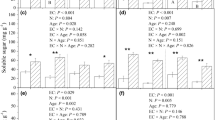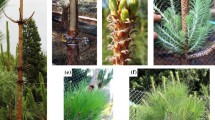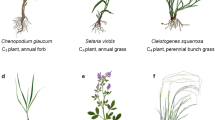Abstract
Many plant species are able to tolerate severe disturbance leading to removal of a substantial portion of the body by resprouting from intact or fragmented organs. Resprouting enables plants to compensate for biomass loss and complete their life cycles. The degree of disturbance tolerance, and hence the ecological advantage of damage tolerance (in contrast to alternative strategies), has been reported to be affected by environmental productivity. In our study, we examined the influence of soil nutrients (as an indicator of environmental productivity) on biomass and stored carbohydrate compensation after removal of aboveground parts in the perennial resprouter Plantago lanceolata. Specifically, we tested and compared the effects of nutrient availability on biomass and carbon storage in damaged and undamaged individuals. Damaged plants of P. lanceolata compensated neither in terms of biomass nor overall carbon storage. However, whereas in the nutrient-poor environment, root total non-structural carbohydrate concentrations (TNC) were similar for damaged and undamaged plants, in the nutrient-rich environment, damaged plants had remarkably higher TNC than undamaged plants. Based on TNC allocation patterns, we conclude that tolerance to disturbance is promoted in more productive environments, where higher photosynthetic efficiency allows for successful replenishment of carbohydrates. Although plants under nutrient-rich conditions did not compensate in terms of biomass or seed production, they entered winter with higher content of carbohydrates, which might result in better performance in the next growing season. This otherwise overlooked compensation mechanism might be responsible for inconsistent results reported from other studies.


Similar content being viewed by others
References
Banta JA, Stevens MHH, Pigliucci N (2010) Comprehensive test of the ‘limiting resources’ framework applied to plant tolerance to apical meristem damage. Oikos 119:359–369
Bartoš M, Janeček Š, Klimešová J (2011) Effect of mowing and fertilization on biomass and carbohydrate reserves of Molinia caerulea at two organizational levels. Acta Oecol 37:299–306
Bell L, Ojeda E (1999) Underground starch storage in Erica species of the Cape Floristic Region: differences between seeders and resprouters. New Phytol 144:143–152
Bellingham PJ, Sparrow AD (2000) Resprouting as a life history strategy in woody plant communities. Oikos 89:409–416
Bond WJ, Midgley JJ (2001) The persistence niche: ecology of sprouting in woody plants. Trends Ecol Evol 16:45–51
Bond WJ, Midgley JJ (2003) The evolutionary ecology of sprouting. Int J Pl Sci 164:103–114
Bowen BJ, Pate JS (1993) The significance of root starch in postfire shoot recovery of the resprouter Stirlingia latifolia R. Br. (Proteaceae). Ann Bot (Oxford) 72:7–16
Budzianowska A, Skrzypczak L, Budzianowski J (2004) Phenylethanoid glucosides from in vitro propagated plants and callus cultures of Plantago lanceolata. Pl Med 70:834–840
Canadell J, López-Soria L (1998) Lignotuber reserves support regrowth following clipping of two Mediterranean shrubs. Funct Ecol 12:31–38
Chew SJ, Bonser SP (2009) The evolution of growth rate, resource allocation and competitive ability in seeder and resprouter tree seedlings. Evol Ecol 23:723–735
Clarke PJ, Knox KJE, Wills KE, Campbell M (2005) Landscape patterns of woody plant response to crown fire: disturbance and productivity influence sprouting ability. J Ecol 93:544–555
Clarke PJ, Lawes MJ, Midgley JJ, Lamont BB, Ojeda F, Burrows GE, Enright NJ, Knox KJE (2013) Resprouting as a key functional trait: how buds, protection and resources drive persistence after fire. New Phytol 197:19–35
Cruz A, Pérez B, Moreno JM (2003) Plant stored reserves do not drive resproutingof the lignotubers shrub Erica australis. New Phytol 157:251–261
Cruz A, Pérez B, Quintana JR, Moreno JM (2002) Resprouting in the Mediterranean-type shrub Erica australis affected by soil resource availability. J Veg Sci 13:641–650
Dalgleish HJ, Hartnett DC (2006) Below-ground bud banks increase along a precipitation gradient of the North American Great Plains: a test of the meristem limitation hypothesis. New Phytol 171:81–89
Ferraro DO, Oesterheld M (2002) Effect of defoliation on grass growth. A quantitative review. Oikos 98:125–133
Huhta AP, Hellström K, Rautio P, Tuomi J (2003) Grazing tolerance of Gentianella amarelle and other monocarpic herbs: why is tolerance highest at low damage levels? Pl Ecol 166:49–61
Hutchings MJ, John EA (2004) The effects of environmental heterogeneity on root growth and root/shoot partitioning. Ann Bot (Oxford) 94:1–8
Janeček Š, Patáčová E, Klimešová J (2014) Effects of fertilization and competition on plant biomass allocation and internal resources: does Plantago lanceolata follow the rules of economic theory? Folia Geobot (this issue) doi:10.1007/s12224-013-9161-5
Janeček Š, Lanta V, Klimešová J, Doležal J (2011) Effect of abandonment and plant classification on carbohydrate reserves of meadow plants. Pl Biol 13:243–251
Klimešová J, Klimeš L (2003) Resprouting of herbs in disturbed habitats: is it adequately described by Bellingham-Sparrow’s model? Oikos 103:225–229
Klimešová J, Klimeš L (2006) CLO-PLA3 – a database of clonal growth architecture of Central-European plants. Available at: http://clopla.butbn.cas.cz
Lamont BB (1985) The comparative reproductive biology of three Leucospermum species (Proteaceae) in relation to fire responses and breeding system. Austral J Bot 33:139–145
Latzel V, Klimešová J (2009) Fitness of resprouters versus seeders in relation to nutrient availability in two Plantago species. Acta Oecol 35:541–547
Latzel V, Klimešová J (2010) Year-to-year changes in expression of maternal effects in perennial plants. Basic Appl Ecol 11:702–708
Latzel V, Malíková L, Klimešová J (2011) Compensatory growth of Euphorbia peplus regenerating from a bud bank. Botany 89:313–321
Latzel V, Hájek T, Klimešová J, Gómez S (2009) Nutrients and disturbance history in two Plantago species: maternal effects as a clue for observed dichotomy between resprouting and seeding strategies. Oikos 118:1669–1678
Latzel V, Klimešová J, Hájek T, Gómez S, Šmilauer P (2010) Maternal effects alter progeny’s response to disturbance and nutrients in two Plantago species. Oikos 119:1700–1710
Martínková J, Klimešová J, Mihulka S (2004) Resprouting after disturbance: an experimental study with short-lived monocarpic herbs. Folia Geobot 39:1–12
Martínková J, Klimešová J, Mihulka S (2008) Compensation of seed production after severe injury in the short-lived herb Barbarea vulgaris. Basic Appl Ecol 9:44–54
Olano JM, Menges ES, Martínez E (2006) Carbohydrate storage in five resprouting Florida scrub plants across a fire chronosequence. New Phytol 170:99–106
Palacio S, Maestro M, Montserrat-Martí G (2007) Relationship between shoot-rooting and root-sprouting abilities and the carbohydrate and nitrogen reserves of Mediterranean dwarf shrubs. Ann Bot (Oxford) 100:865–874
Pate JS, Meney KA, Dixon KW (1991) Contrasting growth and morphological characteristics of fire-sensitive (obligate seeder) and fire-resistant (resprouter) species of Restionaceae (S. hemisphere restiads) from south-western Western Australia. Austral J Bot 39:505–525
Pate JS, Froend RH, Bowen BJ, Hansen A, Kuo J (1990) Seedling growth and storage characteristics of seeder and resprouter species of Mediterranean-type ecosystems of S.W. Australia. Ann Bot (Oxford) 65:585–601
Puijalon S, Piola F, Bornette G (2008) Abiotic stresses increase plant regeneration ability. Evol Ecol 22:493–506
Richards JH, Caldwell MM (1985) Soluble carbohydrates, concurrent photosynthesis and efficiency in regrowth following defoliation, a field-study with Agropyron species. J Appl Ecol 22:907–920
Schutz AEN, Bond WJ, Cramer MD (2009) Juggling carbon: allocation patterns of a dominant tree in a fire-prone savanna. Oecologia 160:235–246
Sosnová M, Klimešová J (2009) Life-history variation in the short-lived herb Rorippa palustris: the role of carbon storage. Acta Oecol 35:691–697
Suwa T, Maherali H (2008) Influence of nutrient availability on the mechanisms of tolerance to herbivory in an annual grass, Avena barbata (Poaceae). Amer J Bot 95:434–440
Tolsma AD, Tolhurst KG, Read SM (2010) Effects of fire, post-fire defoliation, drought and season on regrowth and carbohydrate reserves of alpine snowgrass Poa fawcettiae (Poaceae). Austral J Bot 58:157–168
Trumble JT, Kolodney-Hirsh DM, Ting IP (1993) Plant compensation for arthropod herbivory. Annual Rev Entomol 38:93–119
Verdaguer D, Ojeda F (2002) Root starch storage and allocation patterns in seeder and resprouter seedlings of two Cape Erica (Ericaceae) species. Amer J Bot 89:1189–1196
Verdú M (2000) Ecological and evolutionary differences between Mediterranean seeders and resprouters. J Veg Sci 11:265–268
Vesk PA, Westoby M (2004) Sprouting by plants: the effects of modular organization. Funct Ecol 18:939–945
White LM (1973) Carbohydrate reserves of grasses: a review. J Range Managem 26:13–18
Acknowledgement
This study was financially supported by the Czech Science Foundation, grant No. P505/10/P173, GA 526/09/0963 and the institutional long-term research development project No. RVO 67985939. We are grateful to two anonymous reviewers for their valuable comments on the manuscript and to Jonathan Rosenthal who offered helpful comments and significantly improved our English. We also thank Michaela Latzel for her work on the figures.
Author information
Authors and Affiliations
Corresponding author
Rights and permissions
About this article
Cite this article
Latzel, V., Janeček, Š., Hájek, T. et al. Biomass and Stored Carbohydrate Compensation after Above-Ground Biomass Removal in a Perennial Herb: Does Environmental Productivity Play a Role?. Folia Geobot 49, 17–29 (2014). https://doi.org/10.1007/s12224-013-9162-4
Received:
Revised:
Accepted:
Published:
Issue Date:
DOI: https://doi.org/10.1007/s12224-013-9162-4




